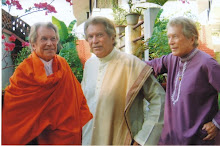Artists and writers have been inspired by its beauty to seek out Santa Fe as a place to live and create since the early 19th century.
A high percentage of residents are affiliated with the arts, with more than 80 art galleries on Canyon Road alone. Many quality museums and theatrical venues reflect a rich cultural life. It is a home for New Age healing, with many centers for yoga, massage and acupuncture.
Santa Fe is nestled in the foothills of the Sangre de Cristo mountains in northeastern New Mexico. Under enormous blue skies, with seemingly boundless high desert landscapes framed by the Sandia peaks to the south and the Jemez mountains in the west, the city invites visitors. At an altitude of 7,199 feet, Santa Fe is the highest and oldest state capital in the United States.
It is not unusual to hear Tewa, Navajo, Spanish and English spoken on the streets of Santa Fe. The unique mix of the tri-cultures of Anglo/Hispanic and Native American (population at just under 70,000), and its colorful history have encouraged tourism to this architecturally beautiful city.
High on the list of “must see” places in the world, Santa Fe has survived a remarkable, diverse events since the arrival of the Conquistadores in 1540 searching for gold in the fabled Seven cities of Cibola.
The city of Santa Fe sits on a site originally occupied by a number of Pueblo villages dating back to 900 A.D. Efforts to colonize the region began in 1598 under the first Spanish governor, Don Juan de Onate. It was its second governor, Don Pedro de Peralta, who founded the city in 1607, made it capital of the province in 1610.
The Pueblo Revolt drove the Spanish out in 1680, but was reconquered a dozen years later by Don Diego de Vargas. It was Spain’s provincial seat until the Mexican War of Independence (1810-1821) when this Mexican territory became known as Santa Fe de Nuevo Mexico.
The Mexican government opened the northernmost territory up to trade, something the Spanish refused to do. The Santa Fe Trail from Missouri to New Mexico brought flourishing business to the area. Santa Fe became a booming commercial hub where Mexicans and Americans exchanged goods and hard currency.
The Mexican-American War in 1846 was an easy victory for the Americans, bringing the territory under U.S. control. The Palace of the Governors constructed by the Spanish on the plaza in Santa Fe became the residence of Governor Lew Wallace, who wrote Ben Hur in 1870 while contending with Indian conflagrations. (The portal running the length of the palace facing the square is a lively enclave today of Native Americans who commute daily from their pueblos to sell their jewelry and small pottery.)
The Palace of the Governors
Willa Cather’s immortal “Death Comes to the Archbishop” relates Frenchman Bishop Jean Baptiste Lamy’s three-decade struggle with both Spanish Catholic and Native American cultures to “elevate” Santa Fe to European standards during the late 19th century. His grandiose St. Francis Cathedral near the plaza is a major tourist attraction today.
St, Francis Cathedral
After much turmoil, New Mexico achieved statehood in 1912 as the 47th state of the United States. At this time, a collective vision of the Santa Fe town council determined that the city should adopt a distinctive look to appeal to tourists. The Spanish Pueblo Revival became official. Many territorial buildings were demolished so that “the City Different” could appear more cohesive in architecture. Regulations limiting the height of buildings and the use of adobe became official. Adobe (sometimes mockingly called “faux-dobe”) charmingly adorns “the City Different,” and it is a continuing visual delight to tourists and residents alike in this Land of Enchantment.
Santa Fe boasts a wide selection of hotels, motels and bed-and-breakfasts. Dining choices cater to all tastes and pocketbooks.
For more information, including the annual Indian Market, Spanish Market, the International Folk Art Market or daytrips to Santuario de Chimayo, Abiquiu, or Ghost Ranch, contact Tourism Santa Fe at (800) 777-2489 or visitwww.santafe.org.











